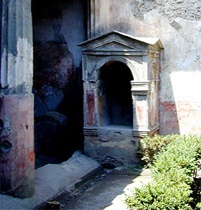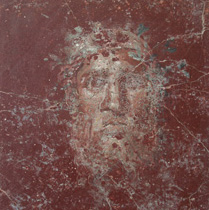 1
1Turning a Shack into a Shrine
This chapter argues that social and cultural interaction in the Roman House was underpinned by an overarching metaphor derived from the concept of a sanctuary. The house as sanctuary engendered security amongst its inhabitants and respectful compliance amongst those who visited. It achieved this via a complex mixture of apotropaic and cathartic motifs that began at the entrance with images such as lion roundels, wall-paintings of winged victories and floor mosaics depicting images such as guard dogs or ships anchors. Other sanctuary metaphors were embedded into in-house shrines (lararia) (fig.1), ancestral images (imagines clipeatae) (fig.2), dedicated sanctuary rooms (sacraria) (fig.3), walled-gardens (paradeisoi) (fig.4), water-shrines (nymphaeum) (fig.5), and, most prolific of all, rooms containing wall-paintings depicting divinities, myths and sanctuaries (fig.6). This highly fetishised environment acted as a gateway to a metaphysical world inhabited by an impressive array of gods, divinities, heroes and family ancestors, all of whom were regularly called upon, through votive acts, to protect and support both the house and its occupants.
Whilst the apotropaic and eschatological function of the above is partially understood, the use of wall-painting to perform a similar function in a domestic context has largely gone unnoticed. This is attributable to their post-discovery designation that almost entirely linked the paintings to the concept of decoration, as well as post-Christian attitudes that favoured the church and not the house as the primary place of worship. Its inverse in pagan culture required the house to be a spiritually charged environment and hence both a cathartic and a secure dwelling. In the case of the Roman house this was primarily achieved via some of the most sophisticated pictorial techniques ever to have existed. The artists who developed them achieved a psychologically seamless transition between architectural and illusionistic space, the like of which was not equalled until the advent of computer-generated virtual reality two thousand years later.
In recent years much has been written about Roman houses owned by the political or mercantile elite. The majority of these texts focused on the way in which this stratum of society used their houses in both public and private contexts. ‘Public’ in this instance is usually taken to mean some form of commercial transaction, political engagement or public patronage, whilst ‘private’ describes those parts of the house that framed relationships conducted between family members, close friends or social equals. This dual reading of the Roman house was largely derived from ancient texts. Its impact on perceptions of Roman wall-painting, particularly relating to social and cultural status, is examined in The House and its Double, and critiqued under the rubric that its near exclusive use of textual material distorted other forms of material evidence. The end result of this distortion was that paintings located in ‘public’ areas appeared to be synonymous with political and economic ambition, whilst those in ‘private’ spaces indulged in hedonistic display. Display, as opposed to conceptual or aesthetic engagement, underpins much of the late twentieth-century literature on the subject. As has been previously argued, for some theorists the mere presence of wall-painting indicates luxury and an attempt to acquire status. This approach avoids in-depth iconological studies that challenge this predominantly literary-derived view of the wall-paintings. This chapter reverses this bias and closely examines iconology, in order to see what it tells us about those who commissioned the wall-paintings and who lived amongst them.
 1
1 6
6
|